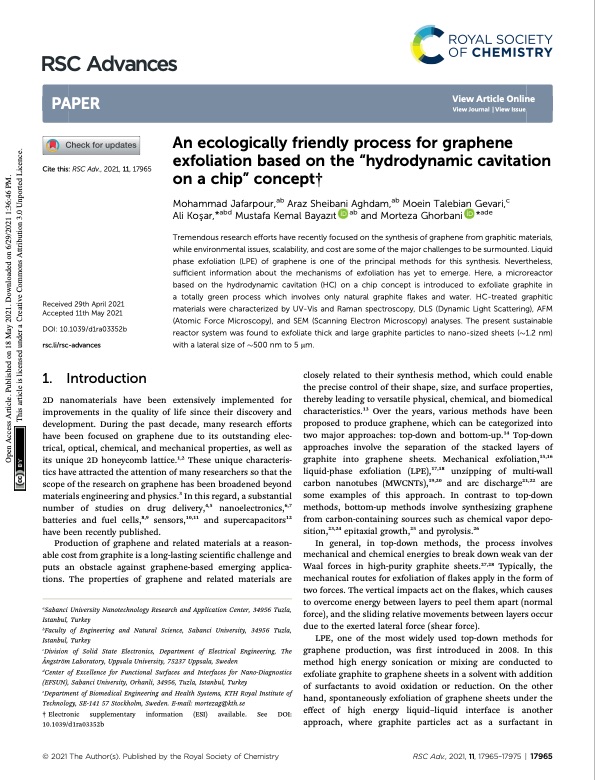
PDF Publication Title:
Text from PDF Page: 001
RSC Advances PAPER Cite this: RSC Adv., 2021, 11, 17965 View Article Online View Journal | View Issue An ecologically friendly process for graphene exfoliation based on the “hydrodynamic cavitation on a chip” concept† Mohammad Jafarpour,ab Araz Sheibani Aghdam,ab Moein Talebian Gevari,c Ali Ko ̧sar,*abd Mustafa Kemal Bayazıt ab and Morteza Ghorbani *ade Tremendous research efforts have recently focused on the synthesis of graphene from graphitic materials, while environmental issues, scalability, and cost are some of the major challenges to be surmounted. Liquid phase exfoliation (LPE) of graphene is one of the principal methods for this synthesis. Nevertheless, sufficient information about the mechanisms of exfoliation has yet to emerge. Here, a microreactor based on the hydrodynamic cavitation (HC) on a chip concept is introduced to exfoliate graphite in a totally green process which involves only natural graphite flakes and water. HC-treated graphitic materials were characterized by UV-Vis and Raman spectroscopy, DLS (Dynamic Light Scattering), AFM (Atomic Force Microscopy), and SEM (Scanning Electron Microscopy) analyses. The present sustainable reactor system was found to exfoliate thick and large graphite particles to nano-sized sheets ($1.2 nm) with a lateral size of $500 nm to 5 mm. Received 29th April 2021 Accepted 11th May 2021 DOI: 10.1039/d1ra03352b rsc.li/rsc-advances 1. Introduction 2D nanomaterials have been improvements in the quality of life since their discovery and development. During the past decade, many research efforts have been focused on graphene due to its outstanding elec- trical, optical, chemical, and mechanical properties, as well as its unique 2D honeycomb lattice.1,2 These unique characteris- tics have attracted the attention of many researchers so that the scope of the research on graphene has been broadened beyond materials engineering and physics.3 In this regard, a substantial number of studies on drug delivery,4,5 nanoelectronics,6,7 batteries and fuel cells,8,9 sensors,10,11 and supercapacitors12 have been recently published. Production of graphene and related materials at a reason- able cost from graphite is a long-lasting scientic challenge and puts an obstacle against graphene-based emerging applica- tions. The properties of graphene and related materials are aSabanci University Nanotechnology Research and Application Center, 34956 Tuzla, Istanbul, Turkey bFaculty of Engineering and Natural Science, Sabanci University, 34956 Tuzla, Istanbul, Turkey cDivision of Solid State Electronics, Department of Electrical Engineering, The A ̊ngstr ̈om Laboratory, Uppsala University, 75237 Uppsala, Sweden dCenter of Excellence for Functional Surfaces and Interfaces for Nano-Diagnostics (EFSUN), Sabanci University, Orhanli, 34956, Tuzla, Istanbul, Turkey eDepartment of Biomedical Engineering and Health Systems, KTH Royal Institute of Technology, SE-141 57 Stockholm, Sweden. E-mail: mortezag@kth.se closely related to their synthesis method, which could enable the precise control of their shape, size, and surface properties, thereby leading to versatile physical, chemical, and biomedical characteristics.13 Over the years, various methods have been proposed to produce graphene, which can be categorized into two major approaches: top-down and bottom-up.14 Top-down approaches involve the separation of the stacked layers of graphite into graphene sheets. Mechanical exfoliation,15,16 liquid-phase exfoliation (LPE),17,18 unzipping of multi-wall carbon nanotubes (MWCNTs),19,20 and arc discharge21,22 are some examples of this approach. In contrast to top-down methods, bottom-up methods involve synthesizing graphene from carbon-containing sources such as chemical vapor depo- sition,23,24 epitaxial growth,25 and pyrolysis.26 In general, in top-down methods, the process involves mechanical and chemical energies to break down weak van der Waal forces in high-purity graphite sheets.27,28 Typically, the mechanical routes for exfoliation of akes apply in the form of two forces. The vertical impacts act on the akes, which causes to overcome energy between layers to peel them apart (normal force), and the sliding relative movements between layers occur due to the exerted lateral force (shear force). LPE, one of the most widely used top-down methods for graphene production, was rst introduced in 2008. In this method high energy sonication or mixing are conducted to exfoliate graphite to graphene sheets in a solvent with addition of surfactants to avoid oxidation or reduction. On the other hand, spontaneously exfoliation of graphene sheets under the effect of high energy liquid–liquid interface is another approach, where graphite particles act as a surfactant in † Electronic supplementary information (ESI) available. 10.1039/d1ra03352b See DOI: © 2021 The Author(s). Published by the Royal Society of Chemistry RSC Adv., 2021, 11, 17965–17975 | 17965 extensively implemented for Open Access Article. Published on 18 May 2021. Downloaded on 6/29/2021 1:36:46 PM. This article is licensed under a Creative Commons Attribution 3.0 Unported Licence.PDF Image | graphene exfoliation hydrodynamic cavitation on a chip

PDF Search Title:
graphene exfoliation hydrodynamic cavitation on a chipOriginal File Name Searched:
graphene-by-cavitation.pdfDIY PDF Search: Google It | Yahoo | Bing
Salgenx Redox Flow Battery Technology: Power up your energy storage game with Salgenx Salt Water Battery. With its advanced technology, the flow battery provides reliable, scalable, and sustainable energy storage for utility-scale projects. Upgrade to a Salgenx flow battery today and take control of your energy future.
| CONTACT TEL: 608-238-6001 Email: greg@infinityturbine.com | RSS | AMP |